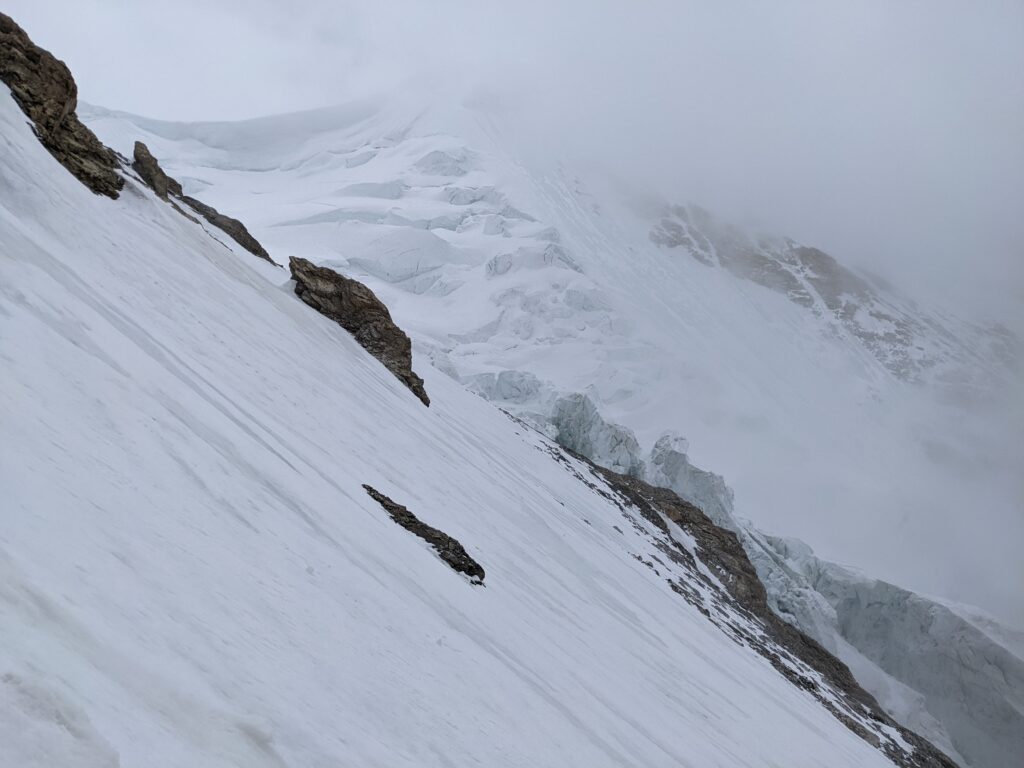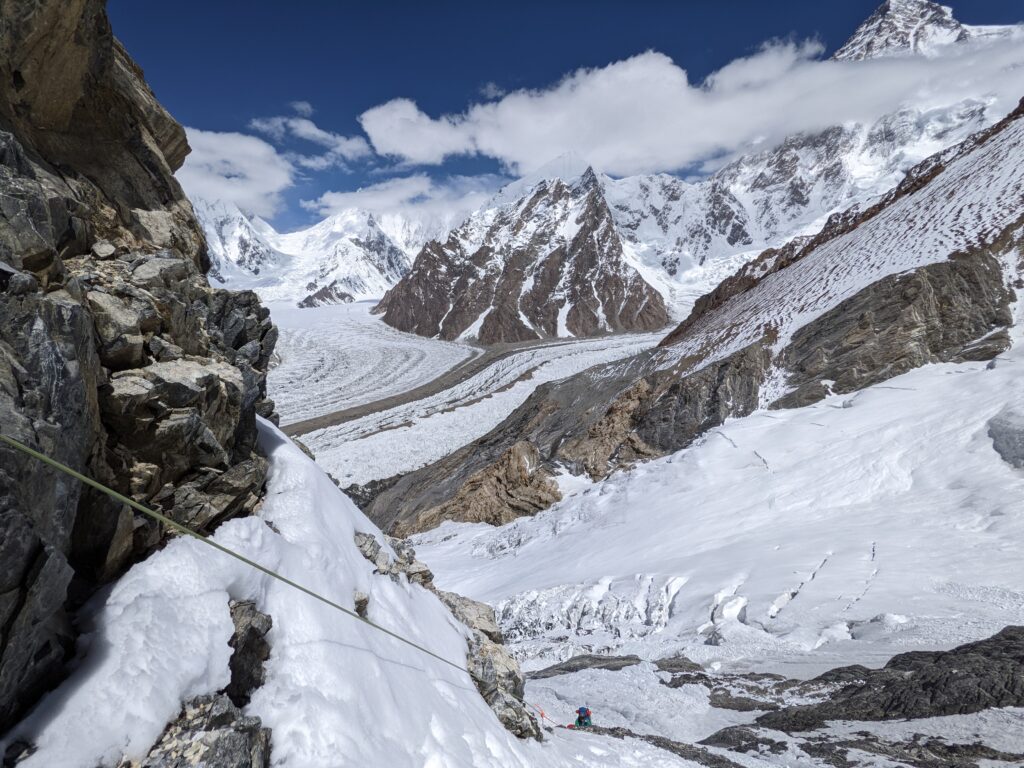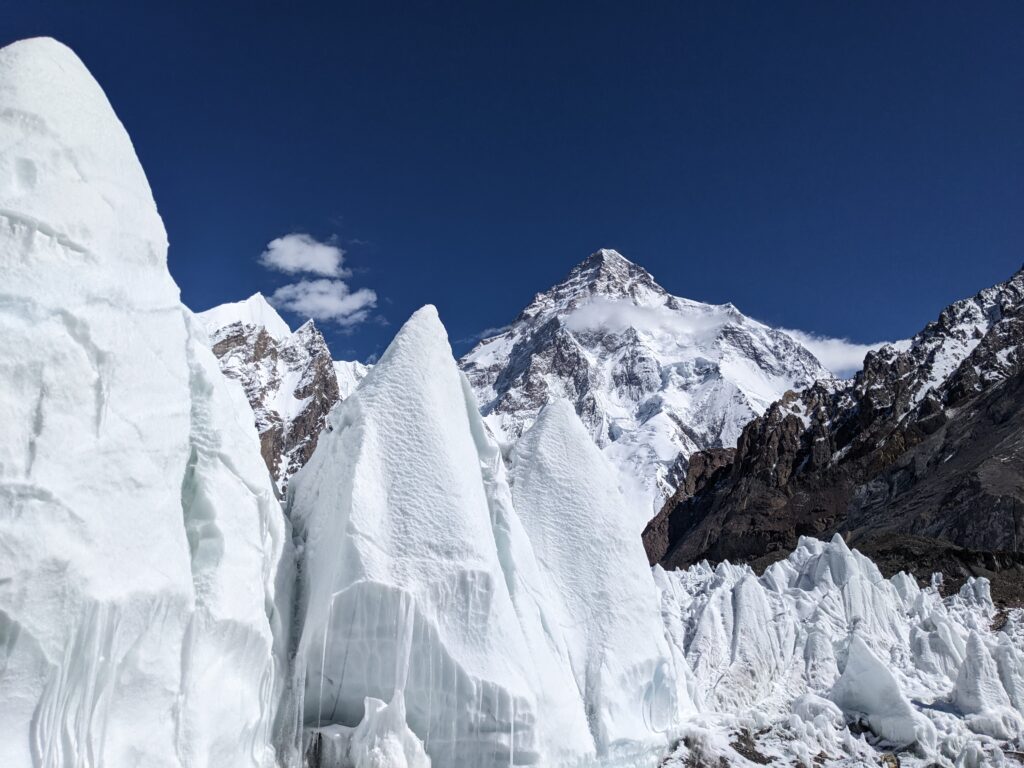After the unsuccessful summit push, it was time to return to camp 3. Needless to say without the darkness, distances became much smaller. At the same time, people (especially those of us climbing without oxygen) were getting very tired. For some of my teammates, climbing down the rocky “chimney” back on the snowy slopes took maybe even longer than climbing up did. While I’d have preferred to use a figure-8 to safely descend at that point, the ropes were such a tangled mess that it wasn’t an option. So I just rolled some of the ropes around my arm and climbed down as quickly as the altitude allowed. Personally I found that the easy part.
The long, snowy descent back to camp 3 was really hard for me. It was the soft, unstable snow. Basically every step meant sinking or sliding with the snow, making it a very frustrating challenge to go down in (needless to say it was an extremely exhausting challenge to climb too). Even with my trekking pole set up for snow, it was hard to take a step without losing my balance. This quickly drained the last of my energy reserves, so I was getting slower and slower, and I reached camp last of the team. The first thing I did (after reporting in) was collapsing in a tent to sleep for three hours or so (I think I didn’t even turn off my GPS tracker, making some people worry—sorry!).
Most of the team (oxygen users, people who turned around and/or felt strong enough) at that point started their descent back to base camp. This left our head guide and two Sherpa with four of us to descend the next day. During the afternoon the weather degraded even further, and it was now consistently snowing. By the next morning we had fresh snow knee deep or even deeper at less windy spots.
We started descent early from camp 3, before the snow would get any worse. It was already a complete whiteout with visibility of only a few meters. This felt like a huge threat, since there are no fixed ropes directly around camp 3. The Sherpa had no trouble finding the rope though even without visibility. I traversed the snow field at camp 3 slowly due to the very deep, soft fresh snow. But as soon as I clipped on the rope, I accelerated and descended much quicker.

In camp 2 we picked up the gear we left there the other day and moved on. I was feeling surprisingly strong, but still I was using the figure-8 to descend most of the day. I knew that even if I feel strong, I was still exhausted both physically and mentally, so safety first. This also meant that we had to spread out, since you can’t belay with a figure-8 if there is someone else on the rope below you. Especially below camp 1 where the anchors are very far away, we had to wait for each other for a very long time to finally clear the rope sections. We also waited for each other at both camp 2 and camp 1, which resulted in lengthy breaks. While we started as early as the snowfall allowed, because of these reasons it was already high noon as I was descending from camp 1.

Because of the heat the snow was of course melting, small rivers forming all over and the snow sliding all the time. As I reached the end of the snow field and started the more complicated steep, rocky section down to crampon point, I was hit in the face by an avalanche (literally).
I was just about to handle an anchor, so I moved close to the rocky wall when the flow or ice, snow and water smashed into me from above. I guess I was lucky that I was close to the rock, so the brunt of the mountain’s love passed above and next to me. This way (thanks to the fixed rope holding me) the only damage was half of my trekking pole (ripped apart), a big bruise on my hip and most of the skin off my nose (the rest of my face was saved by my goggles and buff). It was a very scary experience, but I guess it’s proof that my safety equipment was adequate that I’m alive to tell the tale.

I reached crampon point wet and knees shaking. The rest of the team were safe from the avalanche too. We had a welcoming committee from base camp to help us across the glacier. They brought Coke and took some of our load for the rest of the way. Back in base camp my first thing was to get some hot coffee. My tent was of course a sauna in the midday heat, so I laid our all my wet stuff on and around the tent to dry in the sun (also having my sleeping bag and down suit cover my tent insulates it somewhat from the heat). Having dry camp clothes to change into was great.

Elképesztő, hogy mit éltél át! Igen, egész biztos, hogy nagyon előrelátónek kell lennie, aki a hegy-óriások megmászására szánja el magát. S a legjobb felszrelést kell választani a biztonság (már ha beszélhetünk itt biztonságról!) érdekében. Belegondolni is hátborzongató, hogy hogyan tudtál megküzdeni ezekkel a szavakkal szinte kifejezhetetlen nehézségekkel. Honnan tudtál még energiát mozgósítani, amikor már minden erődet elhasználtad. Fantasztikus tapasztalatokat szereztél!
Milyen jó lenne ezt a történetet kinyomtatva látni, olvasni! Iszonyúan izgalmas, érdekfeszítő, s gyönyörűek a fotók!